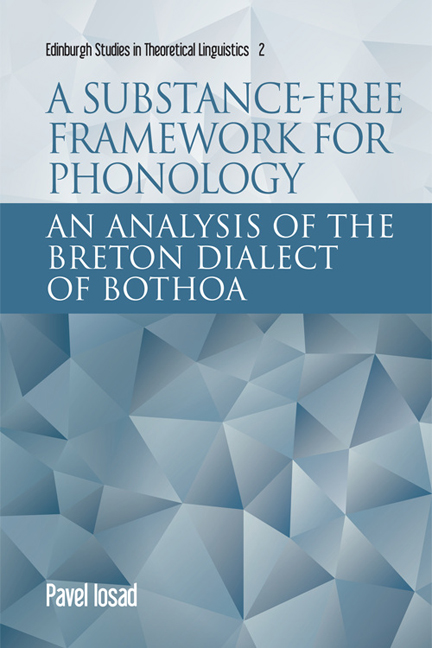Book contents
- Frontmatter
- Contents
- Acknowledgements
- Chapter 1 Introduction
- Chapter 2 Conceptual foundations of substance-free phonology
- Chapter 3 Representational assumptions
- Chapter 4 Computational assumptions
- Chapter 5 Complexity and markedness in substance-free phonology
- Chapter 6 The Breton language
- Chapter 7 Segments and representations
- Chapter 8 Suprasegmental phonology
- Chapter 9 The phonology of vowels
- Chapter 10 The phonology of consonants: palatalisation and gliding
- Chapter 11 Laryngeal phonology
- Chapter 12 Conclusion
- References
- Index
Chapter 7 - Segments and representations
Published online by Cambridge University Press: 20 December 2017
- Frontmatter
- Contents
- Acknowledgements
- Chapter 1 Introduction
- Chapter 2 Conceptual foundations of substance-free phonology
- Chapter 3 Representational assumptions
- Chapter 4 Computational assumptions
- Chapter 5 Complexity and markedness in substance-free phonology
- Chapter 6 The Breton language
- Chapter 7 Segments and representations
- Chapter 8 Suprasegmental phonology
- Chapter 9 The phonology of vowels
- Chapter 10 The phonology of consonants: palatalisation and gliding
- Chapter 11 Laryngeal phonology
- Chapter 12 Conclusion
- References
- Index
Summary
In this chapter I lay out the vowel and consonant inventories of Bothoa Breton and discuss the most important aspects of variation in their phonetic realisation. I also present the proposed featural specifications for these segments that will be used in the following analysis chapters.
Vowel inventory
The inventory of the Bothoa dialect includes long and short oral vowels, as well as several nasal vowels and oral diphthongs. The system of the oral monophthongs is fairly symmetric, with a two-way backness contrast, a symmetrical distinction in length, and two front rounded qualities; its main unusual feature is the apparent presence of three height classes in ‘mid’ vowels. In line with typological expectations, the nasal vowel system is smaller than the oral one, and there is only a very limited length contrast among the nasal vowels. The diphthongs also present a relatively unremarkable system: they are all falling diphthongs with high vowels as non-syllable elements. I consider the three subsystems in turn.
Oral monophthongs
The oral monophthongs are shown in Table 7.1; I refer to Humphreys (1995) for exhaustive (albeit impressionistic) descriptions of their phonetic realisation. Here I concentrate on two aspects of the system that deserve further comment: the mid vowel system and the status of the [ə]/ [o] distinction.
Mid vowels
In the mid vowel region, there is a three-way height contrast for both front unrounded and back rounded vowels. Humphreys (1995) uses the French-based convention of using accents to distinguish among the three heights; I silently retranscribe his symbols as shown in Table 7.2.
Minimal or near-minimal pairs for height contrasts among front vowels are shown in (15). (See section 7.3.2 for explanation of the notation for final obstruents.)
This three-way distinction is characteristic of many Breton varieties. Cf. also Falc'hun (1951), with a generative analysis in Anderson (1981), and Le Du (1978, 2012) and Le Gall (1903) for Tréguier.
- Type
- Chapter
- Information
- A Substance-free Framework for PhonologyAn Analysis of the Breton Dialect of Bothoa, pp. 74 - 94Publisher: Edinburgh University PressPrint publication year: 2017



